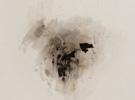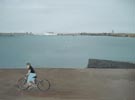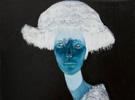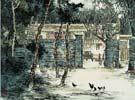Preface
Feng Shi
Over the years, it has always been an awkward topic when we talk about wash painting under the context of contemporary culture.
After Chinese wash painting has experienced a reflection of Cultural Revolution in the 1980s, and the ensuing rebellion and alienation to socialist realism, as well as resistance and rejection about traditional wash painting, and the acceptation and absorption about western contemporary art and post-modern art languages, Chinese wash painting was positioned in a blur, vague and anxious state.
Many scholars even think that Chinese wash painting has lost its culture for survival and development. Into the 1990s, due to China's social, cultural contexts has undergone tremendous changes, especially in the context of globalization, contemporary wash painting consciously link and re-construct by connecting itself to traditional wash painting, in order to get a contemporary value. This not only expands the boundaries of contemporary wash painting, but also connects works with local culture and evolution track of wash painting. Theoretically, it has provides possibilities for contemporary wash painting to establish its value scale and critical discourse.
In today's context of globalization, contemporary and traditional wash painting must correspond to each other. In the contemporary Chinese social and cultural context, with the connotation of Chinese people’s spiritual demands, with the conversion of traditional art language, contemporary wash painting belongs to contemporary art than to wash painting.
In the title of Extended Distance –“Drift Art Group” Third Exhibition of Contemporary Wash Painting, “extended” although has meaning of “heritage”, however the extension is not in one-way, but with more latitude, trying to integrate into the contemporary social and cultural context and transform, making “distance” with traditional teaching, and lead to the emotional resonance and interpretation recognition of the viewers.
It is worth mentioning that the “Drift Art Group” is composed of 11 young artists from mainland and Taiwan. It has time and space meanings of deconstruction and absorption of traditional wash painting and transformation of contemporary painting language: for every participating artist, contemporary and traditional cultural heritage and the distance from the mainland and Taiwan's cultural links and differences, and their many years of wash painting has helped to explore contemporary culture, which attract them to get together and move forward together.
Obsessed with ink technique and effects, both Zhang Yisheng and Wang Yongcheng built very different urban landscape with their brushes; facing the subject of “sex and life”, Tao Gang has choose a rational formalism to paint illusion of life, when Zhao Pingqu uses magnificent colors to bring flowers of life in full bloom; Cai Chenghan outline the broken faces of contemporary people with broken lines, Dou Zhouyan is describing spirit of decadence, black and blue; by also telling little girls' minds, Yang Yi and Lai Jing, one makes stories of young and happiness, the other withdraw; claborate-style painter Chen Lin draws pure beauty of flower and birds; paintings of Liu Xinyi always outpour intensely illusionary fantasies; as a new member, Lin Fanwei shows his rebellious in his “bad painting”, however thankful to the traditional “teachings” to rebel.
Without doubt, the 11 young artists have their own artistic direction and their pace, so I am happy to see them walk on continuously. The result of extension is not that important any more, the best state would be: on the road of pursuit.
Oct. 2011 Tangping Village, Sichuan Fine Art Institute




